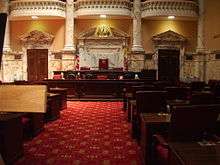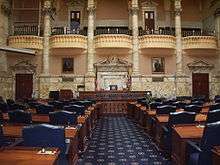Maryland State House
|
Maryland State House | |
|
Maryland State House | |
| Location | Annapolis, Maryland |
|---|---|
| Coordinates | 38°58′43″N 76°29′28″W / 38.97861°N 76.49111°WCoordinates: 38°58′43″N 76°29′28″W / 38.97861°N 76.49111°W |
| Built | 1772 |
| Architectural style | Georgian |
| NRHP Reference # | 66000385 |
| Added to NRHP | October 15, 1966[1] |
The Maryland State House is located in Annapolis and is the oldest state capitol in continuous legislative use, dating to 1772. It houses the Maryland General Assembly and offices of the Governor and Lieutenant Governor. The capitol has the distinction of being topped by the largest wooden dome in the United States constructed without nails. The current building, which was designated a National Historic Landmark in 1960,[2] is the third statehouse on its site.[3] The building is administered by the State House Trust, established in 1969.
Construction
Construction began in 1772, but was not completed until 1797[3] due to the ongoing American Revolutionary War. The two-story brick Georgian style structure, located inside State Circle, was designed by Joseph Horatio Anderson, a noted architect of the time. A small portico juts out from the center of the building, topped by a pediment, with two high arched windows framing the entrance. On both floors, large rectangular windows line the facade. A cornice is topped by another pediment and the sloping roof gives way for a central octagonal drum atop which rests a dome. The large dome is topped by a balustraded balcony, another octagonal drum and a lantern capped by a lightning rod. The rod was constructed and grounded according to the direct specifications of its inventor, Benjamin Franklin.[4][5][6]
The building was surrounded by a low brick wall in 1818 to prevent cattle incursions. This was replaced by an iron fence with a granite base in 1836.[7] The dome of the statehouse is depicted on the Maryland state quarter.
Rotunda
In the rotunda is the Maryland Federalist – a replica built in 1987 of the miniature ship Federalist. Large Corinthian columns support the arches bracing the large dome above. A balustrade lines the second floor balcony.
The replica of the Maryland Federalist is actually on a more or less permanent display in the Lobby at the Thurgood Marshall Baltimore Washington International Airport Terminal. Later in the summer of 2012, the original handwritten text of George Washington's Resignation Letter was on display in the rotunda.
Chambers
Old Senate Chamber
To the right of the entrance is the old Senate Chamber. Chairs and desks were added to the room in the exact number (16) as originally furbished. The desk for the president is an original piece made by John Shaw in 1797.[8]
It was in the Old Senate Chamber that George Washington famously resigned his commission as commander in chief of the Continental Army on December 23, 1783. A mannequin of George Washington stands in period clothing at the front of the room.
Less well known, but important nonetheless, is the historic event that occurred on February 2, 1781 when Governor Thomas Sim Lee, in the presence of the members of both Houses of the State Legislature, signed and sealed the "act to empower the delegates of this state in Congress to subscribe and ratify the Articles of Confederation."[9]
The decision established the requisite unanimous consent of all thirteen states for the formation of a Perpetual Union. This was the final act of formation of the United States of America as a nation. The approval of the much awaited law also removed any doubt about the resolve of the states to unite during the Revolutionary War. In 1861, the fact that "the faith of all the then thirteen States was expressly plighted and engaged that [the Union] should be perpetual" was considered of major importance by President Abraham Lincoln when declaring the secession of the southern states from the Union to be illegal.
The chamber had extensive investigation beginning in 2007 to solve water leakage problems. As a result of this study, restorers have determined that previous restoration attempts in 1905 and 1940 did not accurately recreate many elements of the room. A report of their findings was issued in January 2010 and work continues.[10]
Working Senate Chamber

The Senate chamber is located in a wing added to the original structure between 1902 and 1905. The room is illuminated by a Tiffany-style skylight above. Red carpet emblazoned with the state seal covers the entire floor. Large Ionic columns line the walls and support the viewing gallery. The marble along the walls and the columns are flecked with rust and black, Maryland's official colors.
Two famous Marylanders are featured in statues flanking the podium: John Hanson, the first president by the Articles of Confederation, and Charles Carroll, one of the signers of the Declaration of Independence. Four portraits of Declaration of Independence signatories for Maryland hang on the walls: William Paca, Thomas Stone, Samuel Chase, and Charles Carroll.[11] There are also portraits of Edwin Warfield and John Walter Smith.[12]
Working House Chamber
The House of Delegates chamber is also in the new wing to the building. The carpet is navy blue and designed with a diamond and olive sheaths. The same rust and black marble lines the chamber and forms the Ionic columns along the walls. A spectators' gallery is above the rostrum. The speaker sits in front of a broken marble pediment supporting a clock. Portraits of former Speakers of the House hang on the walls.
Governor's Reception Room
The Governor's Reception Room is on the second floor. The room is mainly ceremonial and used for bill signings. Portraits of former governors hang on the walls. Portraits of Henrietta Maria and Queen Anne hang nearby.[13]
National capital
From November 26, 1783 to August 13, 1784, Annapolis was the capital of the United States. The Congress of the Confederation met in the Maryland State House. Subsequently, Annapolis was a candidate to become the new permanent national capital before Washington, D.C. was built.
United States district court
The United States District Court for the District of Maryland met there for the first decade of its existence.[14] In 1800, judge Samuel Chase tried a local postmaster for embezzlement and sentenced him to thirty-nine lashes. To execute the sentence, the defendant was tied to one of the statehouse columns.[14]
Photo gallery
 Chamber of the Maryland House of Delegates
Chamber of the Maryland House of Delegates The dome of the statehouse is depicted on the Maryland state quarter.
The dome of the statehouse is depicted on the Maryland state quarter..jpg) Maryland State House (front)
Maryland State House (front).jpg) Maryland State House (side)
Maryland State House (side) Maryland State House (rear from below)
Maryland State House (rear from below)
References
- ↑ "Maryland State House". Maryland's National Register Properties. Maryland Historical Trust. Retrieved October 20, 2016.
- ↑ "Designation of Maryland State House as National History Landmark". National Park Service. Retrieved 2011-06-16.
- 1 2 "History of the State House and Its Dome". Maryland State Archives. Retrieved January 29, 2014.
- ↑ "The Dome and Lightning Rod". Maryland State Archives. Retrieved January 29, 2014.
- ↑ "About the State House". Maryland State Archives. Retrieved January 29, 2014.
- ↑ Joseph Scott Mendinghall (February 18, 1975). "National Register of Historic Places Inventory Nomination: Maryland State House" (PDF). National Park Service. Retrieved October 20, 2016.
- ↑ Laura Rice. Maryland History in Prints 1743–1900. p. 92.
- ↑ Jane Wilson McWilliams (2011). Annapolis, City on the Severn, A History. Johns Hopkins University Press. p. 120. ISBN 978-0-8018-9659-0.
- ↑ "An ACT to empower the delegates". Hanson's Laws of Maryland (1780) Vol. 203; Chap. XL. Archives of Maryland. Retrieved 2011-06-16.
- ↑ "Recommendations for Restoration of the Old Senate Chamber" (PDF). Maryland Statehouse Trust. 14 January 2010. Retrieved 2011-06-16.
- ↑ "The State House Annex". Maryland State Archives. Retrieved 2011-06-16.
- ↑ "The Maryland State House – New Senate Chamber". Maryland State Archives. 2007. Retrieved 2011-10-10.
- ↑ "The Maryland State House – Governor's Reception Room". Maryland State Archives. 2007. Retrieved 2011-10-10.
- 1 2 Peter Graham Fish (2002). Federal Justice in the Mid-Atlantic South: United States Courts from Maryland to the Carolinas, 1789–1835. Administrative Offices of US Courts. p. 84. ASIN B004USI36Q.
Further reading
- Thrane, Susan W.; Patterson, Tom (2005). State Houses: America's 50 State Capitol Buildings. Erin, Ontario: Boston Mills Press. ISBN 1-55046-457-4. OCLC 58729303.
External links
| Wikimedia Commons has media related to Maryland State House. |
 Geographic data related to Maryland State House at OpenStreetMap
Geographic data related to Maryland State House at OpenStreetMap- Official website
- Information from the Maryland Archives
- The Maryland State House Trust
- Maryland State House, Anne Arundel County, including photo in 1988, at Maryland Historical Trust
- Historic American Buildings Survey (HABS) No. MD-245, "Maryland State House, State Circle, Annapolis, Anne Arundel County, MD", 101 photos, 12 color transparencies, 48 measured drawings, 3 data pages, 8 photo caption pages

